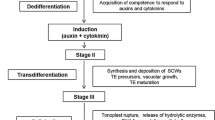Abstract.
Mesophyll cells of Zinnia elegans L., cultured in the presence of phytohormones, will transdifferentiate and undergo programmed cell death to become tracheary elements, thick-walled cells of the xylem. This system is a model system for study of plant cell development and differentiation. We report that a high concentration of extracellular Ca2+ is necessary during the first 6 h of culturing for tracheary elements to form. Extracellular Ca2+ is still required at later times, but at a much lower concentration. When cells transdifferentiate in adequate Ca2+, microsomal phospholipase C activity increases and levels of inositol 1,4,5-trisphosphate rise at about hour 4 of culturing. The production of inositol 1,4,5-trisphosphate appears to be important for tracheary element formation, since inhibitors of phospholipase C inhibit both inositol 1,4,5-trisphosphate production and tracheary element formation. Pertussis toxin, an inhibitor of GTP-binding proteins, inhibits transdifferentiation and eliminates inositol 1,4,5-trisphosphate production. Tracheary element formation was not completely abolished by inhibitors that eliminated inositol 1,4,5-trisphosphate production, suggesting the involvement of other pathways in regulating transdifferentiation.
Similar content being viewed by others
Author information
Authors and Affiliations
Additional information
Electronic Publication
Rights and permissions
About this article
Cite this article
Zhang, X.G., Coté, G.G. & Crain, R.C. Involvement of phosphoinositide turnover in tracheary element differentiation in Zinnia elegans L. cells. Planta 215, 312–318 (2002). https://doi.org/10.1007/s00425-002-0739-z
Received:
Accepted:
Issue Date:
DOI: https://doi.org/10.1007/s00425-002-0739-z




